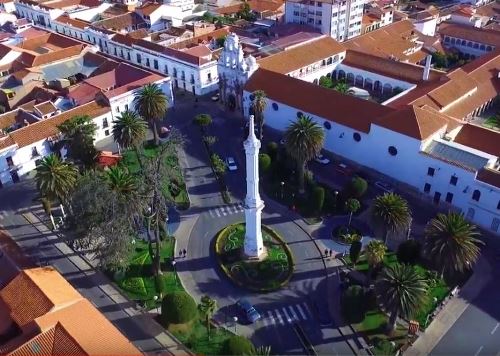|
Sucre, the One and Only Capital of Bolivia Sucre, la Ciudad Blanca (the White City) is a beautiful mid-sized city located in the heart of Bolivia. Its bright white colonial architecture and elaborate cathedral steeples stand out against the stark brown of the Andes Mountains and a slowly growing skyline of modern buildings and unpainted red brick homes.
The City of Four... no, Five... no, Six Names Sucre, located at 2750 meters (9022 feet) above sea level, has been re-named 4 times. It was founded in 1538 by a Spaniard named Pedro de Anzures. The Spanish named it Charcas after the natives who inhabited the area, who called themselves the charcas. This, of course, was before Bolivia gained independence from Spain. At the time, Sucre was the capital of a vast swath of territory called the Real Audiencia de Charcas one of several territorial divisions created by Spain for administrative reasons after the conquest, that covered all of today's Bolivia, and parts of what are now Chile, Peru, Paraguay and Argentina.
The natives themselves (who numbered in the thousands) considered the town the capital of their territory and they called it Choque Chaca (cho-kay-chaw-kaw). In the late 1700's the Spanish changed the name back to Choque Chaca but spelled and pronounced it Chuquisaca (choo-kee-saw-kaw). For over 400 years Chuquisaca flourished and was an epicenter of wealth as many of the Spanish who lived there owned and profited from the silver mines of nearby Potosí, (which in the 1500's and early 1600's was the most populous city on Earth). Sucre was the second largest. So vast was their wealth, that that Spanish families built opulent mansions and even a castle known as La Glorieta, which you can tour today. In 1809 the first public demand for independence from Spain was formally penned in the white city. Close friends Simón Bolívar and Antonio José de Sucre (both from Venezuela) led the fight for independence for 16 long years, until finally in 1825 the region was formally declared an independent nation. The new country was named Bolivia in honor of Simón Bolivar. Bolivar was also named the first president of Bolivia, but he declined and Antonio José de Sucre became president. The city of Chuquisaca was re-named Sucre and declared the capital of Bolivia. After Bolivia declared its independence, other regions of South America continued to fight (and win) independence from Spain as well. After liberating most of South America from Spain, regional border disputes began and the newly independent regions began to form into independent nations. Chile and Bolivia went to war and Bolivia lost a large swath of land, including it's access to the sea. Quarrels with Peru and Paraguay, and an accord with Brazil further decreased the size of Bolivia. When Bolivia's borders were finally defined, it was divided into 9 states, called departments, and Sucre is now also the capital of the Department of Chuquisaca. Did you know that Sucre is the one and only capital of Bolivia? Many people assume, or have been taught in school or seen on a map, that La Paz is Bolivia's capital and are then surprised to learn that this isn't correct. Bolivia has a complicated history. La Paz is considered the seat of government because the Executive and Legislative branches are located there, but the Judicial branch of government remains in Sucre and, according to the Bolivian constitution, re-written and ratified by President Evo Morales' congress in 2009, Sucre remains as Bolivia's one and only capital city. Nearly 500 years and 6 names later, Charcas... Choque Chaca... Chuquisaca... Sucre... the White City... the Chocolate City (wait, what?)... is still a flourishing, vibrant, fascinating city. It's people are pleasant and friendly toward foreigners, many of whom have stayed. There is a large community of North American and European foreigners who now call Sucre home and numerous restaurants, hotels and hostels, are foreign-owned. Sucre is also known as the best city to learn Spanish with a large number of Spanish language institutes and classes being offered there. It is home to the castle of the only prince and princess Bolivia ever had, the largest repository of dinosaur footprints ever found on Earth, many beautiful churches, captivating museums, charming festivals, and today is also known as Bolivia's City of Chocolates! There are so many reasons Sucre is an irresistible, delicious city to visit. Plan Your Trip today! This is our Sucre home page. Click on the links below to find hotels, restaurants, tourist attractions, maps, our Sucre travel forum, and more: How to Get to Sucre, What to Bring     |
